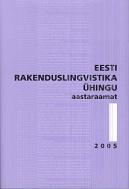Kategooriad inimese kognitiivsel ja sotsiokultuurilisel maastikul
Categories in the human cognitive and sociocultural landscape
Author(s): Silvi TenjesSubject(s): Language and Literature Studies
Published by: Eesti Rakenduslingvistika Ühing (ERÜ)
Keywords: kognitiivne lingvistika; keel ja kognitsioon; kategooria; mälu; projitseering; mõtlemine ; human cognitive ; sociocultural landscape ; estonian linguistics
Summary/Abstract: Categories are important in cognitive sciences. The cognitive science studies generally how category knowledge is represented and specifically how the type of knowledge used for classification is represented. Knowledge came into existence and developed during the categorization process when the developing organism began to use the memory, which later on became an important means of human survival. The ability of an organism to remember important things and events is called the method of knowledge categorization. The cultural and linguistic finds among indigenous people allow to raise a hypothesis that the Ionian Revolution in Greece spread only to the Western cultural space and the perception of the world before the so-called intellectual revolution has survived among some indigenous peoples, having been reflected in their world categorization. Apart from spatial perception and spatial categorization, the linguistic communication world is characterized by the possibility of pointing and translation into something different. Pointing and translation are the most important faculties for the development of linguistic symbolization capacity in the course of evolution. For example, the primary epistemic contrast I – you reflects the first and the most important step in cognitive categorization. The cultural mechanism can be based on emotional memory. Culture is knowledge, transmitted in the course of communication by means of various sign systems. According to this view, culture links cognitiveness and socioculture both in the West and in indigenous cultures. C. Lévi-Strauss (2001) provides some examples of the cultures of indigenous peoples where one can see a smooth transition from a species or a group of species to the system of properties and categories. Mapping seems to be the specific contribution of cognitiveness to linguistics. Meanings are acts or activities. Linguistic meaning is a social act, an intersubjective accomplishment, not a thing. Sinha suggests that meaning is a mapping relationship between a linguistically conceptualized referential situation and a conceptually motivated expression (Sinha 1999: 231).
Journal: Eesti Rakenduslingvistika Ühingu aastaraamat
- Issue Year: 2005
- Issue No: 1
- Page Range: 155-170
- Page Count: 16
- Language: Estonian

